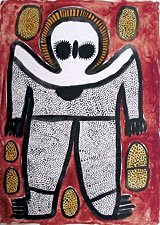
“Karadada,” by Lily K.
|
Ask any trend-spotter about Australian art, and chances are they’ll pipe up about patterns of dots and rhythmic lines and depictions of mysterious Dreamtime Gods and animals. Since the introduction in the early ’70s of acrylic paints to the Aborigines, work by these indigenous peoples has become the emblem of art from that part of the Pacific Rim.
The exhibit at Warren Wilson College’s Holden Gallery features three artists from the Aboriginal community and 16 academically trained painters and printmakers. And the idea of hanging these works together is challenging: The Aboriginal works, in spite of the idea of “untrained” art having a certain look, fit seamlessly into the show. It doesn’t always work the other way around.
Ben McKeown is descended from an Aboriginal mother and a Scottish father. In Australia he has created a series of 20 totem poles representing various dreamings. His work at Holden Gallery is a triptych: The end panels are landscapes — horizontal streaks of impasto in Burnt Sienna bisected with spontaneously applied vertical lines representing scrawny trees. The center panel is a little larger and has strongly patterned, wave-like structures rising and falling against a dark background.
Tim Bass’ small untitled painting is all about, well, paint — but some of the marks suggest windows. Is the viewer outside looking in, or inside looking out? At any rate, the monochromatic work is one that stays on your mind.
Still, “Untitled Suite of Five,” by Vanessa Oter, leaves a more actively lasting impression. Vibrant blues, reds and black marks either fade in and out of, or sit atop, a brilliant yellow ground. There has been much scraping, scratching and rubbing — but the end result is lively and confident. James Taylor’s “Ninety Degrees” also has five panels, but his work is as quiet as Oter’s is garrulous. Oter’s panels march straight across the wall, but Taylor’s climb the space to form an inverted chevron.
Another outstanding abstract painting is by Simon Klose. Controlled but active brush work and subtle, neutral color mark this piece, which is square, but is hung on its point; a couple of very precise lines break the space. Bits of under-painting peek from the edges.
The show’s figurative works are busily varied, though the main attraction of Darien Pullen’s “Torso II Dru” is a stark certainty of line — his headless model shoots out a withering air of defiance. Not to be outdone, Richard Birmingham’s ink-and-wash drawings show us myriad disembodied heads, all looking lost, angry or confused (as well they might). Godwin Bradbeer’s “Profile of 1000 Cuts” is a large mixed-media work on paper. A serious-looking, almost life-sized male profile stares straight ahead. The classically drawn figure is placed in the center of the page, surrounded by a herringbone pattern of inch-long slashes in the paper. The cuts could be something as complex as a comment on self-mutilation or as simple as a matrix creating an effective formal element.

Mark Dober’s “Blockade, Melbourne Casino, 11 September 2000.”
|
Questions immediately arise about Mark Dober’s “Blockade, Melbourne Casino, 11 September 2000” — the viewer feels a palpable tension rare in such a small work. The simply rendered figures are electric; it’s clear something momentous is about to happen. (Turns out Dober actually made the piece on site during an attack by police on peaceful protesters at the Crown Casino, where the World Economic Forum was meeting.)
19 Australian Artists was organized by Robert Godfrey when he spent three months in that country in 2003 as a senior fellow at the Archive of Humanist Art. He was there in that capacity when the U.S. invaded Iraq, and expressed concern that some of the artists in the show might be classified as “persons of interest” by customs when the work was shipped to this country. It’s noteworthy that there seems to be a lack of the egocentricity sometimes found in American artists’ work. Could it be that, to these artists, being allowed to make art is a privilege, carrying with it a responsibility? Refreshing.
[Connie Bostic is an Asheville-based painter and writer. Her work is currently showing at the Meadows Museum in Shreveport, La.]
19 Australian Artists can be seen at Holden Gallery at Warren Wilson College through Friday, March 31.


